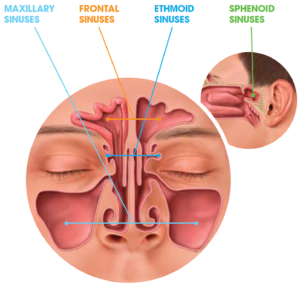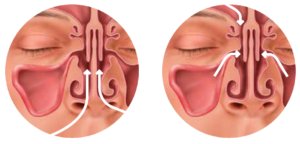PART I
Sinusitis (sometimes called rhinosinusitis) is an inflammation of the tissues lining the sinuses. It can lead to poor or blocked sinus drainage, which causes congestion, headaches, runny nose, loss of sense of smell and taste, and infections. It affects millions of people every year.
What are Sinuses
The sinuses are air-filled pockets in the head. There are four sinuses on each side: the maxillary sinus, the frontal sinus, the ethmoid sinus, and the sphenoid sinus. They are part of the respiratory system located in the nose.
How healthy sinuses work
The sinuses act as a filter for the air we breathe, acting as the first line of defense for protecting the lungs from dust, common pollutants, and bacteria. When you breathe in, mucus in the sinuses humidifies the air and collects pollutants and bacteria. Small hairs called cilia line the sinus cavities and sweep particulates down the throat and into the stomach, where the stomach destroys them.
Sinusitis
Sinusitis is an inflammation of the tissues lining the sinuses. When sinus pathways become swollen or blocked, the sinuses can fill with fluid and build up pressure in the sinus cavities. This can cause nasal congestion and lead to headaches. It also allows bacteria and viruses to accumulate and grow, leading to infections.
The common cold and allergies are the most common causes of sinusitis. Swelling of the lining of the nose is a natural reaction that occurs when an allergen contacts the skin or when you catch a cold. If the swelling occurs in a critical area, e.g., the narrow entryway of a sinus cavity, this can restrict or block the sinuses. This causes the feeling of “congestion” or “stuffy nose.”
Sinus openings are normally quite small. When the openings close down, the sinuses cannot flush particulates down the throat to the stomach. Bacteria can then accumulate and multiply, creating a pocket full of infection and pus. This creates pressure, which is felt as facial pressure or a headache. Excess fluid exits the sinuses and mucous, phlegm, nasal drip or drainage, leading to excessive throat clearing as it passes down through the throat.
Other than colds or allergies, other causes of sinusitis are pollutants, environmental irritants, tobacco smoke, a deviated septum (blockage of the nose), nasal polyps which block the nose, or dental infections. Each of these can also lead to blockages of the sinuses.





